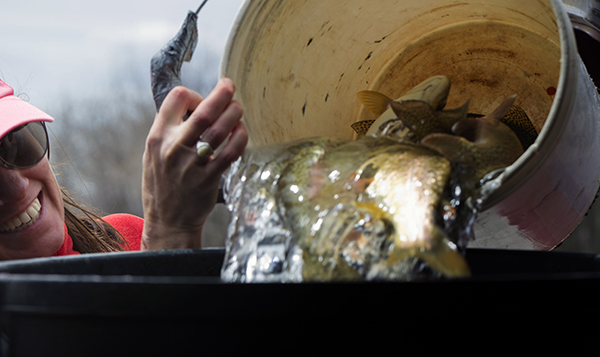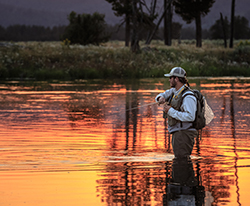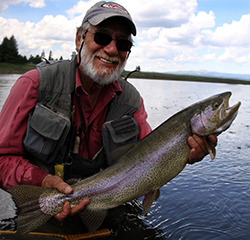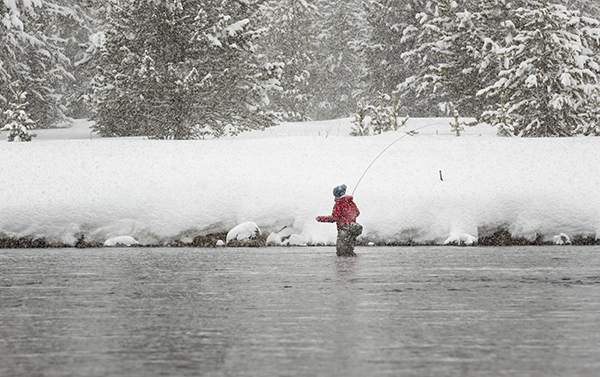As in all recent years, the attention of the Henry’s Fork community was trained on winter flows from Island Park Reservoir at the arrival of 2013. And while carry over storage in the reservoir rather than abundant early snowfall make it possible, negotiated flows were again adequate for trout survival through an Island Park winter. This, combined with reported influence from the Buffalo river fish ladder, was responsible for the biggest news in 2013 as a new record of 6,000 fish per mile was reported by an Idaho Fish and Game survey conducted in May.

Further downstream, evidence of a full recovery from the effects of a recently completed repair project on Ashton Dam was easily observed as conditions altered by the work returned to normal. Virtually silt free, the river resumed its former clarity and with it came a revival of hatches suppressed by nearly three years of disruption created by the urgently needed repair.
Perhaps the best indicator of river health between Ashton and St. Anthony was the strongest appearance of Green Drakes in recent memory. Combined with excellent hatches of Salmon Flies, Golden Stones and the usual assortment of mayflies and caddis, higher water flows kept this section of the river productive well into July. 
Upstream in the caldera section, returning anglers found good fishing to Baetis, March Browns, early caddis, and midges as spring arrived a bit early in the high country. But the quiet of May quickly gave way to the busy month of June and the opening of the Ranch water.
Once again, a lavish appearance of Green Drakes gave witness to a vigorous aquatic environment that also spewed a remarkable assortment of trout tempting hatches on the most popular portion of the river. Morning and evening mayfly activity joined with a scattered emergence of caddis to create continuous fishing action for twelve or more hours on some of the best days.
The summer months of July and August were unusually hot and dry throughout much of the Rocky Mountain West. Unlike many rivers in the surrounding area, however, the Henry’s Fork was spared the disruption of low flows and high water temperatures that forced the closure of numerous notable fisheries. With a full reservoir to deliver irrigation to parched farmland downstream, the river ran higher than usual during the warmest period of summer. And though inconvenient at times for wading, these higher flows served to retain oxygen at levels necessary for trout survival. Greater depth and sustained sunshine created a perfect storm for the growth of aquatic vegetation, particularly in the slower stretches of the river. The upside to this relatively unusual occurrence, were the PMD hatches that poured daily from the dense weed beds. Less enjoyable, however, was the increased difficulty of bringing a big rainbow to the net brought on by the overabundance of in-stream vegetation.

Late summer brought a return of flows closer to normal and also some terrific terrestrial fishing as well. Tricos, Callibaetis and late caddis kept the fish looking up well into September as the weather remained pleasant and water conditions became seasonably stable.
October brought a dramatic cooling trend to the upper reaches of Henry’s Fork country where rain and occasional snow began to dominate the weather pattern. Mahogany Duns were a feature of the warmer days but conditions were generally more suitable for Baetis and midges in a month that warned of an early winter.
As in most years, November was prime time to fish streamers for big autumn browns on the lower river while enjoying temperatures usually a few degrees warmer than in Island Park. Midges and remnant Baetis hatches kept things going until around Thanksgiving time when winter conditions brought early icing to the water and air temperatures considerably lower than an aging man finds acceptable for most outdoor activities.

December and a year’s end have become a time for reflection on the seasons of the Henry’s Fork. There have been highs and lows in every year, and 2013 was no exception.
An unbelievable rainbow taken during a PMD hatch in late June could have never been expected, even on the Henry’s Fork. At a length roughly equal to the butt section of a 9 foot, 4 piece Scott; it was the fish of a lifetime.
The passing of two longtime friends of the river was a loss felt personally and within the community as well. Bob Evans and Hugo Melvoin will be missed.
With Island Park Reservoir depleted to less than 30% capacity, only early snow and diligent effort from the Henry’s Fork Foundation persuaded managers who regulate release of water to provide flows that will protect the fishery through the most critical months of winter. While more snow will be needed moving forward, a reservoir at nearly 60% of capacity and a snowpack just slightly below average were cause for relief and optimism at the end of a very dry year.
Other good news from last year is the announcement that work on the Chester Dam by late winter of 2014 will be completed. This means that a rather elaborate fish ladder at the site will soon allow long barricaded trout to gain access to water upstream from the dam and Fall River as well. This long awaited reconnection is expected to significantly benefit the lower fishery as will fish screens on two canal head gates also located at Chester Dam. As is so often the case in matters pertaining to the river the Henry’s Fork Foundation deserves our gratitude for causing these improvements to be part of the renovation of Chester Dam, which is now generating electricity at the site.
Looking forward in mid-winter, it is difficult to make firm predictions for the New Year. However, the usual indicators thus far point to a continuation of recent trends that have produced a vibrant fishery with strong hatches and plenty of healthy and sizable trout. In 2014, it is good to be alive on the Henry’s Fork.
